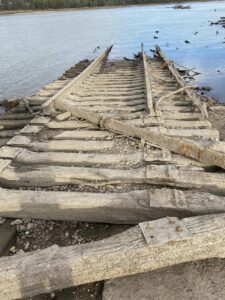
The Mississippi River is low enough to see portions of the train tracks from the old transfer station near the Ste. Genevieve Ferry Landing. To learn more about the transfer station visit the Museum Learning Center! We have a diorama of the transfer station built by Lewis Pruneau, the steam whistle from the transfer station and a slideshow with some great information!
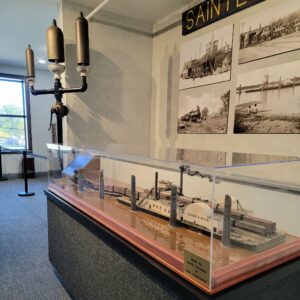
Photos by Carol Schwent.

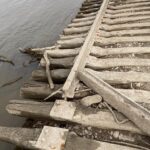
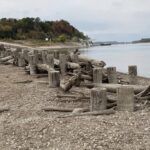
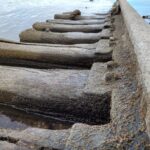





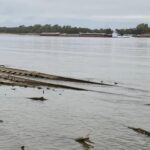
The tracks have been getting its fair share of social media. Jake Jones, Tour Guide/Interpreter at Missouri Department of Natural Resources, posted some background on the railroad and the Ste. Genevieve location to his social media.
While the main focus of this post is at Ste. Genevieve, it is important to give some background on the railroad and this location.
The Illinois Southern railroad came into being in 1900 to haul coal and other goods in the Salem, Centralia, and Sparta areas in Southern Illinois. The ISRR itself was formed with the purchase of two previous railroads.
By 1902 the Illinois Southern had extended their rail line through Evansville, Illinois on to a point called Kellogg. Kellogg is on the Mississippi River directly across from Ste. Genevieve, Missouri.
At this point in time the Illinois Southern had set their eyes on the Lead Belt area of Southeast Missouri.
Seeing as the nearest railroads crossing the Mississippi River were at Thebes (near Cape Girardeau, Mo) to the south and St. Louis to the north, it was not effective to utilize those crossings. Building to either crossing would require many extra miles of track and the right of way to do so.
Another issue hindering the construction of a bridge over the river was topography. Building a tall enough bridge for riverboats to pass under would require large amounts of fill material or a trestle material to build an incline tall enough to cross safely- and space on the Missouri side was limited owing to the steep bluffs.
By 1902 a railroad ferryboat was chosen as the best option. In this setup railcars would be loaded onto a ferry barge and moved across the river.
Construction of the Missouri side was done under the name “Southern Missouri” railroad, though this name was just used for construction. Once the Missouri side of the railroad was built it was all considered the Illinois Southern railroad.
The Illinois Southern in Missouri was built from a location called Thomure just north of Ste. Genevieve. This is the current location of the Modoc vehicle ferry. The rail line ran from Ste. Genevieve to Bismarck.
While the Illinois Southern never quite succeeded in tapping into the lead haulage due to the St. Joseph Lead Company’s operation their own railroad, but it did find other ways to make money.
The mines in St. Francois County required a lot of coal to operate steam equipment in the early years. Since the Illinois Southern passed through the Southern Illinois coal fields, they were able to take care of the need. At one point as many as 70 to 80 coal cars a week were delivered to St. Francois County by the Illinois Southern.
The ISRR also tapped into the rapidly developing lime mining in Ste. Genevieve.
The Illinois Southern operated its first ferry boat, the Nick Saur between 1902 and 1903.
In 1904 their second ferry came into use, the Ste. Genevieve. In 1918 the Ste. Genevieve struck a submerged piling and sank, it was later scrapped. While the Illinois Southern railroad had already added a second ferry in 1916, this left a large dent in their financial stability.
The ferry added in 1916 was the Kellogg and operated until 1920.
In 1921 the Missouri-Illinois railroad was formed and purchased the right of way and equipment of the Illinois Southern. At this time the company purchased the final ferry to operate at Ste. Genevieve, The Ste. Genevieve II.
In 1929 the Missouri-Illinois was acquired by the Missouri Pacific Railroad and operated as a subsidiary company from that point. It was also in 1929 that the Missouri Pacific acquired St. Joseph Lead Company’s Mississippi River and Bonne Terre Railway.
St. Joe began purchasing power generated at Bagnell Dam in Lake of the Ozarks in 1929. While coal was still hauled to St. Francois County for other uses, it was in slightly smaller numbers.
Between 1929 and the end of service the ferry mostly handled general transfer freight.
It is of note that all rail ferries at Ste. Genevieve operated on coal.
Service on the Ste. Genevieve rail ferry ended in 1961, at this point Missouri Pacific chose to route Missouri-Illinois trains via their bridge at Thebes.
The Missouri-Illinois railroad would continue to operate until 1978 when it was absorbed by the Missouri Pacific railroad. The Missouri Pacific was then taken over by Union Pacific in 1982.
While the tracks of the Illinois Southern and later Missouri-Illinois railroad are still used on both sides of the river to some degree, Ste. Genevieve had lost a unique railroad operation.
Years of weathering and changes in river depth and river channels had left any remains of the ferry submerged. The only exception to this is when the river becomes so low that the trestle used to take trains out to the ferry boat becomes exposed.
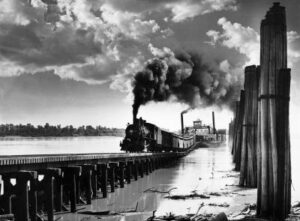 When the river becomes extremely low, the intact railroad track is even exposed. The rails, while the right width for trains, were used to support a large rolling ramp called a cradle. This cradle allowed the train to ramp up to the boat deck, while adjusting to the varying river depths throughout the year.
When the river becomes extremely low, the intact railroad track is even exposed. The rails, while the right width for trains, were used to support a large rolling ramp called a cradle. This cradle allowed the train to ramp up to the boat deck, while adjusting to the varying river depths throughout the year.
If you get the chance, go see it as it is not too common to see this portion of the old trestle. A keen eye may also spot the trestle remains on the Illinois side as well.
I would also like to credit the book: “The Missouri-Illinois Railroad- Missouri Pacific’s Route Through Little the Lead Belt and Little Egypt” by Charlie Duckworth. It is a great book and features many great photos. -Jake
